“Forging Reasonable Hopes: Artificial Intelligence and Digital Narrative” presented by Wingate
Symposium:
Session Title:
- Databases, Interactive Narratives
Presentation Title:
- Forging Reasonable Hopes: Artificial Intelligence and Digital Narrative
Presenter(s):
Abstract:
Abstract
This presentation outlines the artist’s exploration into the possibilities of artificial intelligence in narrative, beginning with the database movie Talk with Your Hands like an Ellis Island Mutt and extending toward a conceptual framework for interactivity that allows for the operation of task-specific intelligent agents.Discussion
Our creative inquiries leads us into theoretical inquiries that shape our future work. As I sought to assemble the videos that comprised Talk with Your Hands like an Ellis Island Mutt I chose the Korsakow cinema database system because it allowed the database itself to make rudimentary “decisions” about the progress of the narrative. The involvement of the system itself in the navigation of the video led me to consider the role of artificial intelligence in narrative, and what role narrative artists may play in shaping it. Korsakow asks authors to break their narratives into what developer Florian Thalhofer calls SNUs—Smallest Narrative Units. For HandMutt, those SNUs were short video clips ranging from six to twenty seconds. In Korsakow, keywords determine navigation from one SNU to the next; each one is labeled with keywords in (lead to the nodes) and keywords out (leading from the nodes).When the SNU above plays, the database will select from other SNUs marked with its specified “out” keywords and display them as thumbnails onscreen, which the interactor then chooses. Because there are usually more choices of SNUs than there are spaces for thumbnails, the database “decides” which SNUs to display for selection. Though it brings no systematic intelligence to its decisions, the Korsakow database is a rudimentary computational actor in the narrative. From there, it was a short step to the subject of artificial intelligence. Though I have found a robust community built around AI and digital narrative (for instance the Artificial Intelligence and Interactive Digital Entertainment conference and the Intelligent Narrative Technologies workshops series), its conversations there tended toward the construction of AI systems rather than toward the decisions artists make when constructing stories. (This is natural, since the AI community is predominantly computer scientists.) Narrative artists can actively prepare for new sets of creative choices that will arise as AI tools develop, as well as participate in that process by defining what specific actions we want artificially intelligent agents to perform.
“General” AI of the type we see in popular film is far off, but smaller-scale AI implementations are much more reasonable. Harvesting interactor data —in the form of choice, biometric information, etc.— enables an AI story manager to participate meaningfully in navigation. Narrative artists can and should be part of the AI conversation by working with computer scientists to create task-specific artificially intelligent agents to function within digital narratives. This puts AI tools in the hands of artists faster and indicates fruitful directions for AI scientists who are developing such tools.





